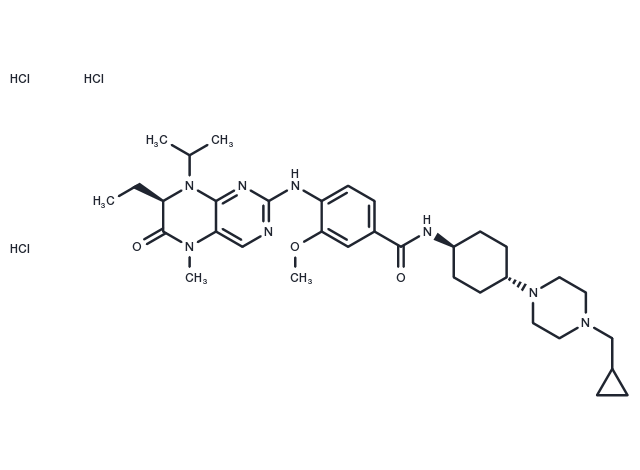Powder: -20°C for 3 years | In solvent: -80°C for 1 year


Volasertib (BI 6727) trihydrochloride is a dihydropteridinone derivative that exhibits potent and selective inhibition of Polo-like kinase 1 (PLK1), PLK2, and PLK3. It acts as an orally active ATP-competitive inhibitor with an IC50 of 0.87 nM against PLK1. Additionally, Volasertib trihydrochloride demonstrates IC50 values of 5 nM and 56 nM against PLK2 and PLK3, respectively. Its mechanism of action includes inducing mitotic arrest and apoptosis. Furthermore, Volasertib trihydrochloride has been shown to possess significant antitumor activity in various cancer models.

| Pack Size | Availability | Price/USD | Quantity |
|---|---|---|---|
| 5 mg | Inquiry | $ 970.00 |
| Description | Volasertib (BI 6727) trihydrochloride is a dihydropteridinone derivative that exhibits potent and selective inhibition of Polo-like kinase 1 (PLK1), PLK2, and PLK3. It acts as an orally active ATP-competitive inhibitor with an IC50 of 0.87 nM against PLK1. Additionally, Volasertib trihydrochloride demonstrates IC50 values of 5 nM and 56 nM against PLK2 and PLK3, respectively. Its mechanism of action includes inducing mitotic arrest and apoptosis. Furthermore, Volasertib trihydrochloride has been shown to possess significant antitumor activity in various cancer models. |
| In vitro | Volasertib trihydrochloride (BI 6727 trihydrochloride) demonstrates varied inhibitory effects across multiple cancer cell lines, with EC50 values ranging from 11 to 37 nmol/L after a 72-hour exposure. Specifically, it significantly inhibits cell proliferation in various cancers, including colon (HCT 116, EC50=23 nmol/L) and lung (NCI-H460, EC50=21 nmol/L) carcinomas, melanoma (BRO, EC50=11 nmol/L), and hematopoietic cancers (GRANTA-519, EC50=15 nmol/L; HL-60, EC50=32 nmol/L; THP-1, EC50=36 nmol/L; Raji, EC50=37 nmol/L). Within 24 to 72 hours at concentrations of 10-1000 nM, Volasertib induces a G2-M phase cell cycle block, evidenced by the accumulation of cells with 4N DNA content, and triggers apoptosis in NCI-H460 cells by 48 hours at a concentration of 100 nM. This compound's effectiveness across a broad concentration range (0.01-10000 nM) underscores its potential in cancer research and treatment, highlighting its role in inducing cell cycle arrest and promoting cell death in cancer cells. |
| In vivo | Volasertib trihydrochloride, administered at varying dosages and frequencies, demonstrates significant anti-tumor activity in human colon carcinoma and non-small cell lung carcinoma xenograft models. Specifically, oral administration of volasertib trihydrochloride at a total weekly dose of 50 mg/kg for 40 days showed comparable efficacy in human colon carcinoma xenografts. Intravenous doses of 15, 20, or 25 mg/kg/day for two consecutive days per week over the same period led to noteworthy tumor growth delay and even regression in these models. Additionally, in a non-small cell lung carcinoma xenograft model, 70 mg/kg given once weekly or 10 mg/kg daily orally significantly impeded tumor growth. A single intravenous dose of 40 mg/kg increased mitotic cells in tumor-bearing mice by 13-fold. The compound exhibits a high volume of distribution and prolonged terminal half-life in both mice (V ss =7.6 L/kg, t 1/2 =46 h) and rats (V ss =22 L/kg, t 1/2 =54 h). Pharmacokinetic analysis further confirmed its extensive distribution and long half-life following a 5-minute intravenous infusion at doses of 35 mg/kg for mice and 10 mg/kg for rats. |
| Synonyms | BI6727trihydrochloride |
| Molecular Weight | 728.2 |
| Formula | C34H53Cl3N8O3 |
| CAS No. | 946161-17-7 |
Powder: -20°C for 3 years | In solvent: -80°C for 1 year
You can also refer to dose conversion for different animals. More
bottom
Please see Inhibitor Handling Instructions for more frequently ask questions. Topics include: how to prepare stock solutions, how to store products, and cautions on cell-based assays & animal experiments, etc.
Volasertib trihydrochloride 946161-17-7 Volasertib BI6727trihydrochloride Volasertib Trihydrochloride inhibitor inhibit
